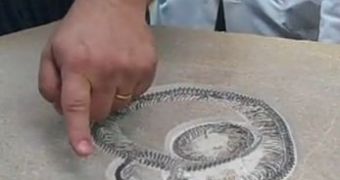Clarisse, the oldest snake to be discovered perfectly preserved in limestone, underwent a CT scan at The Methodist Hospital in Houston, Texas, but the fossil managed to keep some of its secrets, despite all the advanced technology.
The snake was found by paleontologist Hussan Zaher in the Fossil Butte region of Wyoming and it is the only one of her kind known to exist.
Zaher brought the fossil to Huston and had her take a detailed computerized tomography scan, hoping to find where on the timeline of evolution she fitted in.
He said that “most fossilized remains of snakes are individual pieces of bone, [but] this is unique because it's a complete snake, which gives us a unique opportunity to study her makeup and hopefully learn more about her.”
Pam Mager, CT scan technician, conducted the scan on a 64-slice scanner capable of sending laser-guided X-rays through a target.
“We can take almost 3,000 images in less than a minute, and then we can use those images to construct a three-dimensional picture of the snake's bone structure,” she explained.
Zaher is a professor and a curator of the collections of herpetology and paleontology at the Museu de Zoologia of the Universidade de São Paulo in Brazil, and worked with the Museum of Natural Science in Houston to get Clarisse to Methodist for the scan.
He believes the snake could be an evolutionary link between those who take a lot of small bites to eat their prey and those who swallow their prey whole.
After a preliminary look at the images, Zaher said he saw no traces of limbs, which “places it higher up the evolutionary scale, but the snake is still very old.”
“This is a very important step in studying this specimen ... I will be able to take away copies of the images for further investigation and I believe this will help us learn about this snake.
“I cannot express my gratitude enough to (The Methodist Hospital) and the radiology services department here,” he added.
Watch the CT scan video, courtesy of The Methodist Hospital System.

 14 DAY TRIAL //
14 DAY TRIAL //